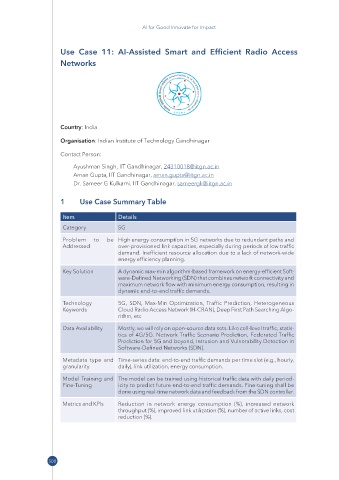Page 344 - AI for Good Innovate for Impact
P. 344
AI for Good Innovate for Impact
Use Case 11: AI-Assisted Smart and Efficient Radio Access
Networks
Country: India
Organisation: Indian Institute of Technology Gandhinagar
Contact Person:
Ayushman Singh, IIT Gandhinagar, 24310018@iitgn.ac.in
Aman Gupta, IIT Gandhinagar, aman.gupta@ iitgn .ac .in
Dr. Sameer G Kulkarni, IIT Gandhinagar, sameergk@ iitgn .ac .in
1 Use Case Summary Table
Item Details
Category 5G
Problem to be High energy consumption in 5G networks due to redundant paths and
Addressed over-provisioned link capacities, especially during periods of low traffic
demand. Inefficient resource allocation due to a lack of network-wide
energy efficiency planning.
Key Solution A dynamic max-min algorithm-based framework on energy-efficient Soft-
ware-Defined Networking (SDN) that combines network connectivity and
maximum network flow with minimum energy consumption, resulting in
dynamic end-to-end traffic demands.
Technology 5G, SDN, Max-Min Optimization, Traffic Prediction, Heterogeneous
Keywords Cloud Radio Access Network (H-CRAN), Deep First Path Searching Algo-
rithm, etc
Data Availability Mostly, we will rely on open-source data sets. Like cell-level traffic, statis-
tics of 4G/5G. Network Traffic Scenario Prediction, Federated Traffic
Prediction for 5G and beyond, Intrusion and Vulnerability Detection in
Software-Defined Networks (SDN).
Metadata type and Time-series data: end-to-end traffic demands per time slot (e.g., hourly,
granularity daily), link utilization, energy consumption.
Model Training and The model can be trained using historical traffic data with daily period-
Fine-Tuning icity to predict future end-to-end traffic demands. Fine-tuning shall be
done using real-time network data and feedback from the SDN controller.
Metrics and KPIs Reduction in network energy consumption (%), increased network
throughput (%), improved link utilization (%), number of active links, cost
reduction (%).
308

